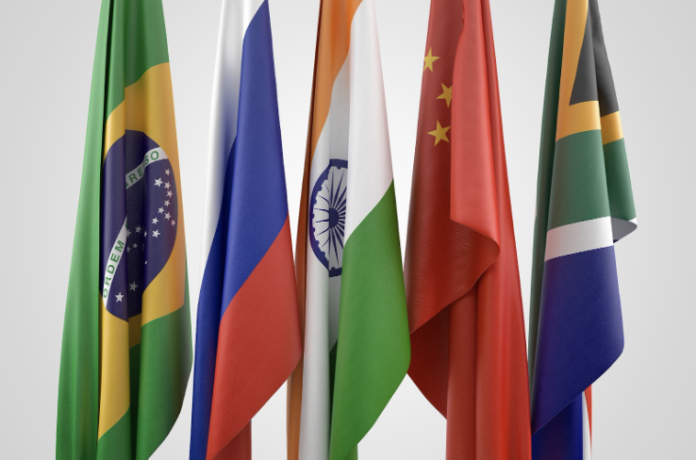![]()
Leaders from across the globe gathered to attend the 15th annual “BRICS” Summit in Johannesburg, South Africa on Aug. 22, 2023. The summit concluded with the announcement of the planned admission of six new members to the group, more than doubling its membership. This development has caused uproar across the Western world as fears grow over China’s increasing geopolitical influence. This paranoia is unfounded—the potential of BRICS to become an international force is limited. However, its popularity offers important insights for U.S. foreign policy.
History
Ministers from Brazil, Russia, India and China began meeting in 2006 to explore ways to increase cooperation between their countries. The move was intended to promote growth in each state’s emerging economy. In 2009, the group held their first official summit in Yekaterinburg, Russia. The joint statement released after this conference advocated for greater representation of the Global South in world economic institutions, open international trade and reaffirmed the collective’s mutual commitment to economic cooperation.
In 2010, South Africa applied and was admitted to the collective. Each successive annual summit has been accompanied by an increasingly ambitious agenda. In 2012, the group founded the New Development Bank as an alternative to Western finance institutions, such as the International Monetary Fund (IMF). Since that time, BRICS countries have further increased their cooperation and grown their own economic platforms together.
15th Annual Summit
President Cyril Ramaphosa of South Africa welcomed President Luiz Lula da Silva of Brazil, President Narendra Modi of India and President Xi Jinping of China to the 15th annual BRICS Summit on Aug. 23, 2023. Due to outstanding warrants for his arrest issued by the International Criminal Court (ICC), Russian President Vladimir Putin attended the summit virtually from Moscow. The group extended invitations to 67 states across the world, many of which attended the conference.
At the summit, members reaffirmed their commitment to economic cooperation and advocated for a multi-polar world order. Member states placed significant emphasis on changing international institutions to better reflect the globe’s population demographics.
To conclude the summit, the five member states agreed to admit six new countries as full members of the collective. The agreement represented a dramatic departure from previous policy, considering that the group had not admitted any new members since South Africa in 2010. Argentina, Ethiopia, Egypt, Iran, Saudi Arabia, and the United Arab Emirates are now slated to join BRICS, effective Jan. 1, 2024.
Internal Divides
Many journalists and politicians across the Western world have decried the expansion of BRICS as a threat to the established liberal order. They fear that China and Russia have gained international influence by attracting other countries to join their pact.
However, BRICS is not a formal pact or alliance. It is a loose confederation of states that share an aversion to Western economic institutions. Examining the original BRICS framework through other lenses reveals a deeply divided group of states with conflicting interests. Expansion only exacerbates this problem, further limiting the group’s potential for meaningful cooperation.
India and China, for example, have conflicting interests. China aspires to become the regional hegemon in East Asia. This scenario would be devastating for India, itself a rising power. The two countries share a disputed 2,100 mile Himalayan border, which has been the site of several skirmishes between the two countries in recent years. China also maintains a close partnership with Pakistan, further complicating this fraught relationship. During the week of Sept. 3, 2023, Chinese and Pakistani military personnel began joint military drills in northwestern China. India has launched a series of parallel drills along its Pakistani and Chinese borders. In order to counter growing Chinese influence, India has recently engaged in a series of high-level diplomatic engagements with the United States. It also joined the U.S.-led Quadrilateral Security Dialogue. Given India’s interest in counterbalancing Chinese power, it seems implausible for the two countries to cooperate in any strategically significant domains.
The proposed expansion of BRICS would bring even worse internal divisions to the fold. As it stands, both Saudi Arabia and Iran are set to join the collective on Jan. 1, 2024. These two regional powers have conflicting interests in the Middle East. This is perhaps best demonstrated through the Yemeni Civil War, fought between the Yemeni government and Shiite rebels since 2014. In 2015, Saudi Arabia began an intervention against the rebelling Houthis in Yemen. Iran has since supplied arms to the Houthis, resulting in an effective proxy war between the two countries.
It must be acknowledged that Saudi Arabia and Iran have recently made meaningful progress in diplomatic ties with the help of Chinese mediation. In Mar. 2023, the two agreed to normalize ties, representing a dramatic shift in the relationship. However, these regional powers have a long history of animosity rooted in a sharp religious divide. As a result, they are likely to continue competing for influence in the Middle East for the foreseeable future. This in turn limits the potential for cooperation between the two states.
Insights for the G7
Although the expansion of BRICS does not constitute a significant challenge to the liberal democratic order, its growth does indicate an opportunity for the U.S. and other G7 nations. In an article published in Foreign Policy, columnist C. Raja Mohan argues that the U.S. should counter the expansion of BRICS by re-engaging members of the Global South. The increasing popularity of BRICS certainly indicates that developing economies are searching for an alternative to Western economic institutions. Indeed, the U.S. and its allies are particularly guilty of ignoring the Global South in the years since the Cold War. As a result, these countries are looking elsewhere for investment and partnership.
Mohan is therefore correct in concluding that G7 countries should renew their efforts to engage developing countries on economic partnership. Many developing countries are looking for financial capital and Western states are in a position to provide it. However, this engagement must be mutually beneficial and undertaken in good faith by both parties in order to be successful. Partnerships must promote mutual growth and development through long-term sustainable engagements.
Western observers should rest assured knowing that internal divides are likely to prevent BRICS from emerging as a significant challenge to the liberal democratic order. However, its growth demonstrates an opportunity for Western states to engage developing countries in meaningful and rewarding partnerships. Such an approach would counter Chinese influence while building strong connections across the developing world.












